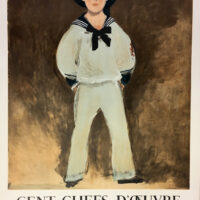Description
The poster was designed by Geneva University, using as subject the drawing in coloured inks which Picasso produced for Geneva University. Lithograph Centre Culturel
Pablo Diego José Francisco de Paula Juan Nepomuceno María de los Remedios Cipriano de la Santísima Trinidad Ruiz y Picasso (25 October 1881 – 8 April 1973) was a Spanish painter, draughtsman, and sculptor. He is one of the most recognized figures in 20th-century art. He is best known for co-founding the Cubist movement and for the wide variety of styles embodied in his work. Among his most famous works are the proto-Cubist Les Demoiselles d’Avignon (1907) and Guernica (1937), his portrayal of the German bombing of Guernica during the Spanish Civil War.Picasso demonstrated uncanny artistic talent in his early years, painting in a realistic manner through his childhood and adolescence; during the first decade of the twentieth century his style changed as he experimented with different theories, techniques, and ideas. Picasso’s creativity manifested itself in numerous mediums, including painting, sculpture, drawing, and architecture. His revolutionary artistic accomplishments brought him universal renown and immense fortunes throughout his life, making him the best-known figure in twentieth century art.
Posters as an art form were invented by Jules Chéret in Paris in the 1860’s. Their proliferation and refinement were the result of advances in printing technology, a relaxation of laws regulating the press, and a booming demand for the advertisement of ‘modern’ products and of the Parisian lifestyle in the Belle Epoque (1871 – 1914). In journals, books, theater programs, and posters, the graphic arts soon transcended their commercial function and became art objects sought out by art collectors worldwide.




















